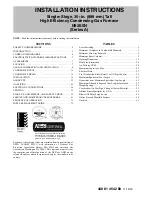
11
Table 2 – Minimum Space Volume for 100% Combustion and Ventilation Air from Indoors -- Ft
3
(M
3
)
Other Than Fan---Assisted Total
(1,000 Btuh)
Fan---assisted Total (1,000’s Btuh)
ACH
30
40
50
50
75
100
125
0.60
1,050 (29.7)
1,400 (39.2)
1,750 (49.0)
1,250 (35.0)
1,875 (52.5)
2,500 (70.0)
3,125 (87.5)
0.50
1,260 (35.3)
1,680 (47.0)
2,100 (58.8)
1,500 (42.0)
2,250 (63.0)
3,000 (84.0)
3,750 (105.0)
0.40
1,575 (44.1)
2,100 (58.8)
2,625 (73.5)
1,875 (52.5)
2,813 (78.8)
3,750 (105.0)
4,688 (131.3)
0.30
2,100 (58.8)
2,800 (78.4)
3,500 (98.0)
2,500 (70.0)
3,750 (105.0)
5,000 (140.0)
6,250 (175.0)
0.20
3,150 (88.2)
4,200 (117.6)
5,250 (147.0)
3,750 (105.0)
5,625 (157.5)
7,500 (210.0)
9,375 (262.5)
0.10
6,300 (176.4)
8,400 (235.2
10,500 (294.0)
7,500 (210.0)
11,250 (315.0) 15,000 (420.0) 18,750 (525.0)
0.00
NP
NP
NP
NP
NP
NP
NP
ACH = Air Changes per Hour
NP = Not Permitted
Table 2 Minimum Space Volumes
were determined by using the
following equations from the National Fuel Gas Code ANSI
Z223.1/NFPA 54--2009, 9.3.2.2:
1. For appliances
other than fan--assisted appliances
(such
as a draft hood--equipped water heater), calculate using the
following equation:
1000 Btu / hr
21 ft
3
(
I
other
)
Required Volume
other
²
ACH
2. For
fan--assisted appliances
(such as this furnace), calcu-
late using the following equation:
1000 Btu / hr
15 ft
3
(
I
fan
)
Required Volume
fan
²
ACH
where:
I
other
= all appliances
other than fan--assisted
input in Btu
per hour
I
fan
=
fan--assisted appliance
input in Btu per hour
ACH
=
air change per hour (percent of volume of space
exchanged per hour, expressed as a decimal)
3. For purposes of this calculation, an infiltration rate greater
than 0.60 ACH shall not be used in the equations above.
The following requirements apply to the
Standard
Method and to
the
Known Air Infiltration
Rate Method.
S
Adjoining rooms can be considered part of a space, if there are
no closeable doors between rooms.
S
Combining spaces on the same story. Each opening shall have
a minimum free area of at least 1 in.
2
/1,000 BTUH (2,200
mm
2
/kW) of the total input rating of all appliances in the space
but not less than 100 in.
2
(0.06 m
2
). One opening shall
commence within 12 in. (305 mm) of the top, and one opening
shall commence within 12 in. (305 mm) of the bottom, of the
enclosure. The minimum dimension of air openings shall not
be less than 3 in. (76 mm).
S
Combining spaces in different stories. The volumes of spaces
on different stories shall be considered as communicating
spaces where such spaces are connected by one or more
openings in doors or floors having a total minimum free area of
2 in.
2
/1,000 BTUH (4,400 mm
2
/kW) of total input rating of all
appliances.
S
An attic or crawl space may be considered a space that freely
communicates with the outdoors provided there are adequate
ventilation openings directly to outdoors. Openings
MUST
remain open and
NOT
have any means of being closed off.
Ventilation openings to outdoors
MUST
be at least 1 square
inch of free area per 4,000 BTUH (550 mm
2
/kW) of total input
rating for all gas appliances in the space.
S
In spaces that use the
Indoor Combustion Air
Method,
infiltration should be adequate to provide air for combustion,
ventilation and dilution of flue gases. However, in buildings
with unusually tight construction, additional air
MUST
be
provided using the methods described in section titled
Outdoor
Combustion Air Method
:
S
Unusually tight construction is defined as Construction with:
1. Walls and ceilings exposed to the outdoors have a continu-
ous, sealed vapor barrier. Openings are gasketed or sealed
and
2. Doors and openable windows are weather stripped and
3. Other openings are caulked or sealed. These include joints
around window and door frames, between sole plates and
floors, between wall--ceiling joints, between wall panels, at
penetrations for plumbing, electrical and gas lines, etc.
Ventilation Air
Some provincial codes and local municipalities require
ventilation or make--up air be brought into the conditioned space
as replacement air. Whichever method is used, the mixed return
air temperature across the heat exchanger
MUST
not fall below
60
°
so that flue gases will not condense excessively in the heat
exchanger. Excessive condensation will shorten the life of the
heat exchanger and possibly void your warranty.
Venting and Combustion Air Check
NOTE
: If this installation replaces an existing furnace from a
commonly vented system, the original venting system may no
longer be sized to properly vent the attached appliances. An
improperly sized venting system may cause the formation of
condensate in the vent and the leakage or spillage of vent gases.
To make sure there is adequate combustion air for all appliances,
MAKE THE FOLLOWING CHECK
.
Typical Gas
Water Heater
Draft Hood
Vent Pipe
Match
A07688
Fig. 6 -- Vent Check
The following information is supplied to allow the installer to
make adjustments to the setup of existing appliances,
IF
REQUIRED,
based on good trade practices, local codes, and
359AA
V












































